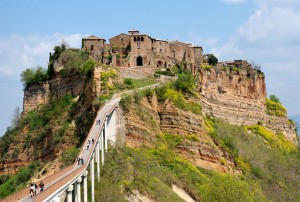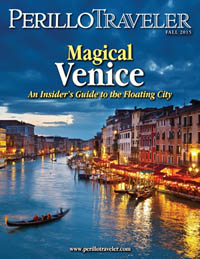 A millennia-old Etruscan outpost in the middle of Lazio, Civita di Bagnoregio rises precariously from the volcanic rock. It seems anchored squarely atop the rugged hill, where it has sat for 2,500 years, but is in grave danger of collapse, both figuratively and literally.
A millennia-old Etruscan outpost in the middle of Lazio, Civita di Bagnoregio rises precariously from the volcanic rock. It seems anchored squarely atop the rugged hill, where it has sat for 2,500 years, but is in grave danger of collapse, both figuratively and literally.
Only a tiny handful of people live here year-round – the population fluctuates, but is limited to less than a dozen – as poor job prospects prompted masses of people to emigrate from Civita in the 1970s. Many haven’t returned, leaving the ancient town mostly vacant according to The New York Times.
Over several centuries, as much as the land gave rise to this spectacle, nature has reclaimed the town. Its Italian nickname, il paese che muore, means “the town that is dying.” Erosion slowly chips away at the hillsides due to rain, with an estimated 10 occurring in the last year; while some are benign, others are more threatening to the tiny community, such as a landslide that destroyed the only land bridge leading into the city.
“Rain gets into the fractures of the volcanic rock and creates alterations. In the last five centuries, we’ve seen a reduction of the cliff by about 20 percent due to landslides,” geologist Giovanni Maria Di Buduo told The New York Times.
Now, however, Civita is on the verge of resurrection. The town expects to receive half a million visitors this year, attracted by regional tourism efforts that have promoted the city and placed its image on buses in Rome. To accommodate visitors, residents have turned many abandoned buildings into bed and breakfasts, restaurants, and shops, including Sandro Rocchi, who returned to the city to help with his children’s restaurant after moving away in the 1970s.
The influx of tourists has caught the attention of the government of the Lazio region, which is now brainstorming ways to help save and preserve Civita. It is a UNESCO World Heritage site candidate, and Lazio officials are pushing to save the town through a 10-year comprehensive conservation plan and lobbying for a national law to grant funding and special status to Civita.
“The place has come back to life,” Rocchi said.
The city actually comprises two towns: Civita, the hilltop city, and Bagnoregio, down the hill from a connecting path (made of concrete, to replace the bridge that was destroyed by a landslide). Civita was originally built as a military bastion, but became isolated when it no longer provided a strategic advantage. Now a pristine, peaceful village, Civita boasts Italian charms such as truffle hunting, stunning scenery of greenery clinging to the chalky volcanic tuff, biannual donkey races in the piazza, and a Good Friday procession to march the cathedral’s crucifix into Bagnoregio.
“The fragility of Civita is bad, but it is also what makes it unique,” said Luca Profili, deputy mayor of Bagniaregio. “It is the idea that you have it today, but you don’t know if you will have it tomorrow.”
By Kathy McCabe
 Want to read more about travel? Get your free copy of our new digital magazine, Perillo Traveler!
Want to read more about travel? Get your free copy of our new digital magazine, Perillo Traveler!
